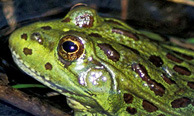Features

Rancho San Bernardino
Adjacent to each other but on opposite sides of a border is an international effort to manage this vast and biologically rich landscape.
Working Together

Refuge Gallery
Enjoy images of San Bernardino National Wildlife Refuge’s landscape and the wildlife that call it home all or part of the year.
Refuge's Photo Galleries

Helping Threatened Amphibian
The Chiricahua leopard frog is only known to occur in Arizona, New Mexico, and Mexico. A distinctive call separates it from other frogs.
Student Makes a Difference

Critical Habitat is Designated
for the threatened San Bernardino springsnail. This tiny species of Hydrobiids is 2mm and under. Its shell has whorls (twists).
Species Profile

Protecting The Largest Big Cat
in the United States - the jaguar. This endangered cat is known to occur in the nearby Peloncillo Mountains.
Endangered Species Profile

Cooperative efforts between the U.S. Fish and Wildlife Service and landowners in both the United States and in Mexico are providing tremendous opportunities to conduct research, restore and secure habitat and water sources, and introduce and maintain self-sustaining fish and wildlife populations and habitats.
Partnering for WildlifeAbout the NWRS

The National Wildlife Refuge System, within the U.S. Fish and Wildlife Service, manages a national network of lands and waters set aside to conserve America’s fish, wildlife, and plants.
Learn more about the NWRS
- July 31, 2015
San Bernadino National Wildlife Refuge (Refuge), in compliance with the National Environmental Policy Act of 1969, has prepared a draft Environmental Assessment (EA), Hunt Plan and Compatibility Determination for continued hunting on the Refuge. The Refuge considered whether to maintain the existing hunting program, expand hunt opportunities, or close hunting altogether. Copies of these documents are available at the link below.
The public is encouraged to submit written comments to San Bernadino NWR, Attn: Hunt Plan/EA, P.O. Box 3509, Douglas AZ, 85607. Written Comments will be accepted until 4:30 pm on Friday, August 28, 2015.
Draft Hunt Plan & Environmental Assessment 
In 1903 President Theodore Roosevelt established the Pelican Island Bird Reservation, the first of 50 refuges he would create during his time in office and the roots of what is today known as the National Wildlife Refuge System. Seen here with Gifford Pinchot, President Roosevelt's legacy is reflected at San Bernardino National Wildlife Refuge, a landscape set aside and managed for the benefit of wildlife.
Working for Wildlife and You

The primary role of San Bernardino National Wildlife Refuge is to provide recovery for the native fish in the Río Yaqui watershed.
Learn more
Page Photo Credits — Yaqui chub/W. Radke, San Bernardino National Wildlife Refuge Entrance/J. Greff, San Bernardino's Photo Gallery images/W. Radke, Threatened Chiricahua leopard frog/W. Radke, Threatened San Bernardino springsnail/W. Radke, Jaguar / Gary Stoltz ©, USFWS, San Bernardino's Yaqui catfish survey/W. Radke, President Theodore Roosevelt with Gifford Pinchot, Yaqui topminnow female and male, female beautiful shiner, and catfish/W. Radke, All photos courtesy of USFWS unless otherwise noted.
Last Updated: Jul 31, 2015